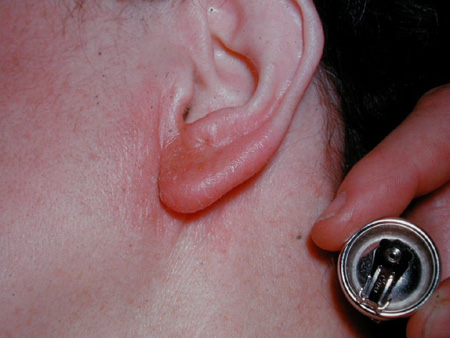Approach
Contact dermatitis can occur (and should be suspected) at any age and can be caused by products that have been used for a long time because sensitisation can occur at any point in life.
The clinical presentation of contact dermatitis is highly variable, depending on the causative agent, the affected body areas, and the duration of symptoms. Suspect contact dermatitis in patients with no previous history of dermatitis who present with a sudden onset of acute dermatitis, or in a patient with existing atopic dermatitis but new areas of presentation, or uncontrolled flares despite adequate topical treatments.
History and examination
Patients generally report pruritus, burning, erythema, swelling, and blistering with acute contact dermatitis (ACD), and pruritus, burning, erythema or hyperpigmentation, fissuring, and scaling with chronic contact dermatitis. The appearance of contact dermatitis may be indistinguishable from atopic dermatitis and psoriasis. Post inflammatory hypo- or hyperpigmentation can occur from both irritant contact dermatitis (ICD) and ACD.
Permanent depigmentation resembling vitiligo (leukoderma) has been reported to various contact allergens including rubber, hair dye, and adhesives.[19][20][21]
The eruption is often clearly delineated with sharp borders and confined to the areas where the irritant or allergen has come into contact with the skin.
Signs of secondary infection may occur, especially in chronic contact dermatitis with fissuring, leading to the appearance of honey-coloured crusting over open skin areas.
Location of symptoms often gives clues as to the causative agent and should prompt questioning about recent exposures, occupational history, recreational activities, hobbies, environmental changes, and changes in cosmetics, perfumes, jewellery, hygiene products, and skin care products.[22]
[Figure caption and citation for the preceding image starts]: Allergic contact dermatitis to nickel in watchbandFrom the personal collection of Dr Snehal Desai [Citation ends]. [Figure caption and citation for the preceding image starts]: Allergic contact dermatitis to nickel earringFrom the personal collection of Dr Snehal Desai [Citation ends].
[Figure caption and citation for the preceding image starts]: Allergic contact dermatitis to nickel earringFrom the personal collection of Dr Snehal Desai [Citation ends]. [Figure caption and citation for the preceding image starts]: Allergic contact dermatitis to nickel in belt buckleFrom the personal collection of Dr Snehal Desai [Citation ends].
[Figure caption and citation for the preceding image starts]: Allergic contact dermatitis to nickel in belt buckleFrom the personal collection of Dr Snehal Desai [Citation ends].
Irritant contact dermatitis (ICD)
Symptoms of burning and stinging are more common and can occur in the absence of other symptoms. ICD may be caused by frequent hand washing, exposure to harsh detergents, personal care products that contain potential irritating ingredients such as benzoyl peroxide and retinoids commonly used for acne or mascara, and eyelid cosmetics left on for long durations.
ICD occurs within minutes to hours of exposure to a strong irritant and within days to weeks of exposure to a weak irritant. ICD is usually confined to the area of exposure, usually involving the hands and/or face. ICD often improves after several weeks in the absence of repeat exposure.[9]
Allergic contact dermatitis (ACD)
Signs and symptoms are caused by delayed-type hypersensitivity and usually occur 24 to 72 hours after exposure, but can present later in some patients. Improvement of dermatitis within a few days after exposure supports a diagnosis of ACD, but many cases of ACD may persist, even with infrequent exposure. The geometric shapes of the lesions are sometimes characteristic of contact dermatitis (i.e., linearly configured lesions in ACD caused by Toxicodendron species, or square-shaped ACD caused by bandage adhesive or topical antibiotics such as neomycin).[23] ACD usually begins in the area of exposure, but can spread to other areas and also become a systemic reaction (auto-eczematization). The properties of different geographical areas of skin can determine whether they are affected in ACD. For example, ACD caused by paraphenylenediamine in hair dye can spare the thicker skin of the scalp and instead affect the face, ears, and neck where the skin is thinner. Similarly, shampoo and conditioner allergy may preferentially affect the face in a 'rinse-off' pattern affecting the lateral sides of the face and back of the ears. ACD to deodorant or antiperspirant often spares the axillary vault but instead affects the skin around the axilla due to increased perspiration in the vault washing the allergens to the edge. Footwear contact dermatitis often spares the arch of the foot given the decreased contact with the sole of the shoe compared with the rest of the foot.
Investigations
In many cases, history and physical examination alone are not sufficient to make the diagnosis of contact dermatitis or to differentiate between ICD and ACD. Patch testing is the most specific and sensitive test for the diagnosis of contact dermatitis. It is the gold standard diagnostic test for patients with suspected contact dermatitis.[16][22] Screening patch test trays composed of the most common allergens are often used, especially if the history and physical examination do not point towards a possible aetiology. If history and physical examination hint at a particular allergen, more specific patch testing trays can be used. For example, a dental allergen screening tray can be used to evaluate suspected occupational contact dermatitis in a dental worker.[22]
Polysensitisation occurs more often in patients with atopic dermatitis and hand dermatitis, suggesting that a higher index of suspicion for ACD and lower threshold for utilisation of patch testing should be considered in these patients.[22][24] Referral to a contact dermatitis expert with extensive experience in the placement and interpretation of patch tests is important.
A standardised strip patch test is proposed to improve diagnosis of allergic contact dermatitis beyond the patch test.[25][26] Its application in routine clinical practice can be recommended, especially if the conventional patch test is presumed false negative.[26]
When patch testing is not available, or the result is equivocal, a repeated open application test can be used, particularly for leave-on products.[16][22]
ICD is a diagnosis of exclusion and can be considered when ACD has been excluded by patch testing. All patients with treatment-resistant dermatitis should be patch tested to evaluate for a contact aetiology.
Skin biopsy is required if the diagnosis is in doubt, the condition is chronic, or the patch tests are negative. A biopsy will not differentiate between irritant and contact dermatitis in most cases, but may be useful in determining, but may be useful in determining whether an alternate inflammatory skin disorder is present (e.g., psoriasis, cutaneous T-cell lymphoma).[22]
Use of this content is subject to our disclaimer